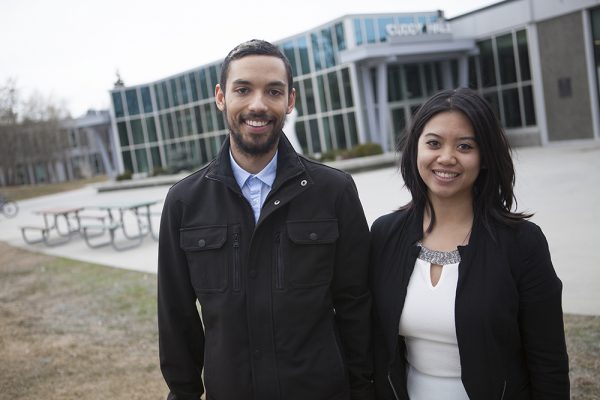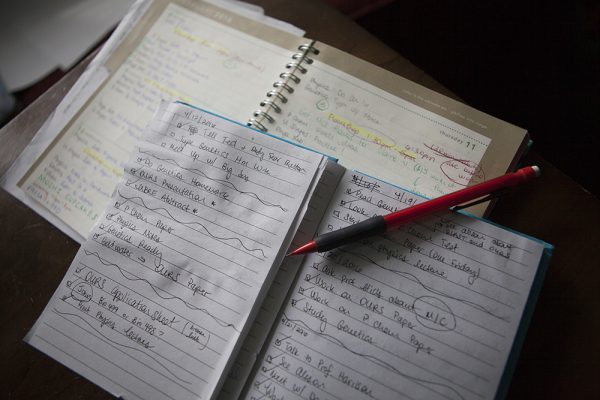AHAINA names UAA's 2016 Man and Woman of Excellence
by Tracy Kalytiak |
What first inspired this year's UAA AHAINA Man and Woman of Excellence, Kenyon Wright and Chelsea Parrocha, to delve into science?

The UAA Multicultural Center's AHAINA program chose Kenyon Wright and Chelsea Parrocha to be its 2016 Man and Woman of Excellence. (Photo by Philip Hall / University of Alaska Anchorage)
Psychology fascinated Kenyon, an aspiring pediatrician who is taking that passion to know why and using it in his undergraduate research to learn whether viewing what he calls "cute" pictures of creatures with a low forehead, small mouth and large eyes will increase how careful people become while driving.
Chelsea, on the other hand, found her scientific calling as a seventh-grader when she watched a video describing how saliva from a Gila monster can be used to treat Type II diabetes. Now, she's a junior biological sciences major researching the disrupted development of kidneys in threespine stickleback fish exposed to perchlorate, and pursuing her goal of becoming a pharmaceutical toxicologist.
AHAINA-an acronym that stands for African American, Hispanic, Asian-Pacific Islander, International and Native American-is a program of the UAA Multicultural Center that aims to further the success of minority students and promote diversity at UAA. The organization hosts the Men and Women of Excellence Ceremony every academic year to acknowledge rising juniors who have maintained a cumulative grade-point average of 3.0 or higher and have demonstrated an ability to balance academic, social and volunteer efforts.
Finding 'the pearl in the sea'
Kenyon came to live in Alaska 10 years ago, when his family settled in Houston. He came from a family rooted in the military: his father served in the Marine Corps, his brother is serving in the Navy, his grandfather served in the Air Force and his uncle served in the Army.
"It was hard leaving friends every year or two," Kenyon said of the nomadic life of a military "brat", which he said had an up side: "It made me more adaptable and flexible, to find the pearl in the sea and experience other cultures and places."
One of his favorite places was Amarillo, Texas, where he lived from ages 8 to 10. "The people there were so friendly and down to earth," he said.
Kenyon's family moved to Alaska after his grandmother's diabetes mellitus worsened. "We wanted to be here to take care of her," he said.
He attended Houston middle and high schools: "We were all this one big family," he said of the easygoing atmosphere he found in school, which helped him discover and explore psychology and other sciences.
"I always wanted to know what's going on in any biological system," Kenyon said.
Kenyon was a UA Scholar who graduated as valedictorian of Houston High School's Class of 2013 and served as vice president of the National Honor Society.
So what are the underpinnings of the "cuteness" experiments? "Some research suggests that behavioral response is an evolutionary development," Kenyon said, which elicits people's protective instincts.
Kenyon is pursuing a bachelor's degree in biological sciences, with a concentration in the UAA University Honors College. Outside class, Kenyon volunteers at Bean's Café and in the pediatrics department of Providence Alaska Medical Center. He also enjoys a variety of sports, plays the trumpet (which he says is "on the back burner due to time") and is "a huge geek, a technophile" who loves videogames.
"There's a huge stigma if you play videogames, that they're deleterious," he said. "But I actually learned to read through videogames. That was one of the driving factors. My parents said if I wanted this game, I'd have to read this. It's definitely one of the things that promoted my reading skills!"
This summer, Kenyon will transition to cancer research with Professor Holly Martinson, who teaches in the Alaska WWAMI program.
His late grandmother inspired his career choice.
"She didn't let sickness affect her life," he said. "She was one of the best people; you could tell she was in pain, but she didn't show it to you."
Helping others overcome their health challenges is Kenyon's goal.
"Being a doctor is one of the most rewarding jobs," he said. "To be able to treat patients and fulfill altruistic capacities-I just want to do that."
'A beautiful paradox'
Chelsea Parrocha grew up in Anchorage, the only child in a family that nurtured her affinity toward the sciences and music.
"I was surrounded by my heritage, in the Filipino community," said Chelsea, who learned Filipino cultural dances and became a dance teacher.
Chelsea says she was always interested in "studying life." "My mom got me into gardening at a young age," she said. "I love flowers, I love green, I just love the earth. In elementary school, we would get salmon eggs and watch them grow. Science came naturally to me, effortless. It was just fun. I never really thought of it as academics but pretty much just learning, being enthralled by figuring out how things work around you."
Seeing that integrated-sciences video in seventh grade about the medicinal use of a Gila monster's saliva galvanized her desire to become a scientist.
"I became so enamored by that concept of taking a substance from a deadly creature and converting it to save lives," she said. "I just found that to be a beautiful paradox, and I still do to this day."
She decided to pursue a career as a pharmaceutical toxicologist: "That's really what's been motivating me to go through the sciences," she said.
Following her eighth-grade year, she heard about an all-girls STEM conference that featured female professionals in STEM-related fields offering mentorship opportunities. "Toxicology was featured there and I literally circled that," she said. "I rallied up the rest of my friends who were mostly interested in medical-related fields."
Chelsea involved herself in Alaska BioPREP's BioTaPP (Biotechnology Training and Preparatory Program) at Polaris K-12 School. In 2013, she won second prize in an Alaska Science and Engineering Fair and COSEE Ocean Science Fair team project (with Taylor Seitz) that focused on detection of paralytic shellfish poisoning. That project won the 2013 Stockholm Junior Water Prize for the state of Alaska.
Through the Anchorage School District's gifted mentorship program, she job shadowed the chief analytical chemist at the Alaska State Public Health Laboratory. "He was able to show me typical assays that would be run for toxicology-related fields," she said.
Chelsea is accustomed to leading a full life. "I remember in high school, I literally had a club or activity to do every lunchtime, every single day of the week," she said.
She decided to attend UAA because of the many scholarship opportunities she received. She is pursuing a bachelor's degree in biological sciences, with minors in music and chemistry and concentration in the Honors College, where she also works as a student assistant.

The UAA Multicultural Center's AHAINA program chose Kenyon Wright and Chelsea Parrocha as its 2016 Man and Woman of Excellence. Here is a photo of the planners Chelsea uses to manage her frenetic schedule. (Photo by Philip Hall / University of Alaska Anchorage)
"From high school I did recognize I aspired to go to graduate school," she said. "I figured I would go to UAA because of the scholarship opportunities and because it's 15 minutes away from my house, five minutes if I'm speeding-not that I've tried that! I just wanted to feel my hometown a bit more before I decide to leave for graduate school."
She's been taking music classes, singing in Defiant Requiem with UAA University Singers and Anchorage Concert Chorus at the Alaska Center for the Performing Arts, and hopes eventually to sing with friends who are in UAA Glee Club. And, she's worked as an undergraduate researcher since her freshman year.
"Chelsea has learned skills in fish histology, computer imaging and data analysis, and her work has been so excellent that she is now a co-author on a major manuscript that we are submitting to the journal General and Comparative Endocrinology," said Professor Frank von Hippel, her research mentor. "Her research has important implications for kidney disease in people and animals exposed to this contaminant."
Chelsea is managing a light load of 12 credits this semester; last semester, she took 18. Last summer, she worked three jobs-two that related to research-and took a summer class. She relaxes by making jewelry, drawing and painting.
"I've always been a busy body," she said.
She says she is trying to become less busy, but until that happens, she maintains a system that keeps her organized.
"I'm very old-fashioned; I need to write everything down," she said. "I have a planner, which gives me my overall things I need to do-my classes and what assignments or readings are scheduled that specific day. I have another notebook, which gives me my everyday to-do list in terms of my objectives, setting an intention for myself to get as many things crossed off my list as possible."
She works as a student assistant at the Honors College and helps out during holiday seasons at Hummel's Flowers.
"For Valentine's week, they own my soul pretty much, for what I can give them," she laughed. "Mother's Day week is coming up, and I'll be helping out with preparations for that after finals."
Written by Tracy Kalytiak, UAA Office of University Advancement
 "AHAINA names UAA's 2016 Man and Woman of Excellence" is licensed under a Creative Commons Attribution-NonCommercial 4.0 International License.
"AHAINA names UAA's 2016 Man and Woman of Excellence" is licensed under a Creative Commons Attribution-NonCommercial 4.0 International License.









